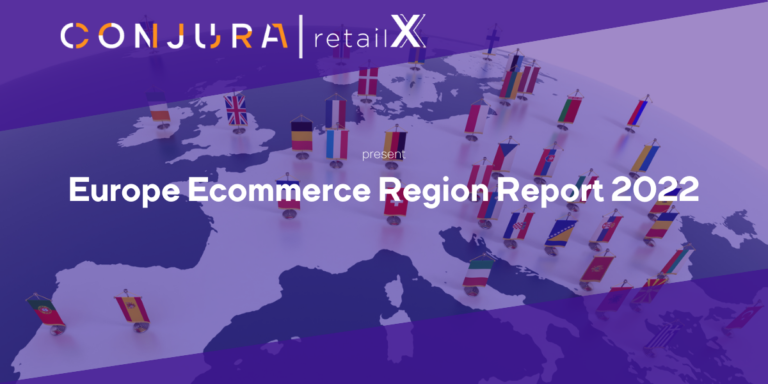Report Highlights Pressure on European eCommerce Businesses

Seismic shift Needed in Supply Chains as RetailX and Conjura Report Highlights Unprecedented Pressure on European eCommerce Businesses
Research shows a plummeting supply of container ships and soaring Freight costs, pinpointing the UK as the most expensive European shipping destination. While the report also illustrates a transformation in consumer buying habits - people are buying in smaller quantities and moving online to shop in significant numbers
DUBLIN, IRELAND, August 23, 2022-- Post-pandemic slowdown, war in Ukraine and global inflation have heaped significant pressure on the logistics ecosystem to source, provide and protect products, as well as on the eCommerce businesses who find themselves facing steeper prices and unreliable supply. The 2022 Europe eCommerce Region Report authored by Internet Retailing, through their research brand, RetailX in partnership with leading eCommerce data analytics platform Conjura, surveyed 34 European countries to determine current trends in European eCommerce and indicate where the retail sector may be headed. The report details how eCommerce businesses face headwinds in areas such as Covid 19, inflation, sustainability and supply chain but at the same time see tailwinds in internet adoption, movement to online purchasing, logistics improvements and ease of internationalization.
The ocean-cargo industry has been acutely impacted by the aftershocks from the pandemic as well as the war in Ukraine and the energy crisis. Fragility in the supply chain means transporting products long distance has become precarious. Manufacturers and distributors are battling to replace or refill inventories while big brands such as Italian clothing company, Benetton, German luxury fashion house, Hugo Boss, and Swedish-founded furniture firm, IKEA, have moved or expanded their factories in Turkey from previous locations in South East Asia.
With production shortfalls blamed for 75% of the current reduction in global volume of trade, obstacles in the supply chain account for the rest. Ballooning costs and short supply of material and containers result in raised prices, which are ultimately handed on to consumers. Some brands can absorb inflationary costs, and others cannot - it is left for companies to look for ways to optimize performance and operational efficiency which result in assured financial decisions.
“This is a challenging time for European eCommerce and one which will make or break businesses, depending on how well they can innovate, automate and in some cases re-engineer their key operational functions.” said Fran Quilty, Co-Founder and CEO of Conjura, and a contributing author of the report.
“Consumers are becoming more discerning regarding where they shop and becoming quicker to leave brands should they be unhappy with the service. To adapt, businesses must harness end-to-end, data-driven insights from across their operations, in order to anticipate and resolve issues, effectively evaluate the supply chain and source more intelligently.”
The report also found that consumers are buying in smaller quantities, trading down in terms of the brands they select and delaying purchases. Companies have been charged with finding new suppliers, transport routes, manufacturing sites, and more broadly, have had to review the supply chain in its entirety. This leaves a gap for innovative technology to help buttress supply chain readiness. Brands need to be robust in their planning and forthright in their willingness to adapt - the more a firm embraces relevant, helpful technology, the more likely their survival and market impact will be guaranteed.
Additional key findings from the report:
- Home is where the heart is: Consumers are staying local following the pandemic, with 40% of European shoppers preferring to buy from local businesses
- Moving online: Close to a third of purchases (31.8%) in the UK are now made online. In Portugal, the equivalent figure is 8.4%. Serbs are least likely of all Europeans to shop online, with just 3.7% of purchases taking place online.
- Costs an arm and a leg: The UK is the most expensive shipping destination (24.2% higher compared with mainland Europe as other reports have demonstrated)
- Home brands = Winning brands: According to the Europe eCommerce report, the majority of shoppers (88%) purchase from sellers in their own countries, with 31% of respondents saying they also buy from sellers from other EU countries. Only 22% shop from suppliers from the rest of the world
- Abandoned ship: Supply of container ships have fallen by 11% across the board
- European shopping habits: The amount of eShoppers vary significantly per region in Europe - ranging from 74% in western Europe to 48% in Eastern Europe. The UK has the highest ratio of regular online shoppers out of the European countries surveyed
- Staying indoors: Over 20% of consumers in the European countries surveyed said they had switched from a brick-and-mortar store to an online store in the last 4-6 weeks or will switch in the next 4-6 weeks
- No waiting around: The trend to shop locally can also be seen in the last-mile section of the supply chain, with direct to consumer shipments rising 14% each year between 2015 and 2020
View the 2022 Europe eCommerce Region Report: https://bit.ly/3PDRjbn




